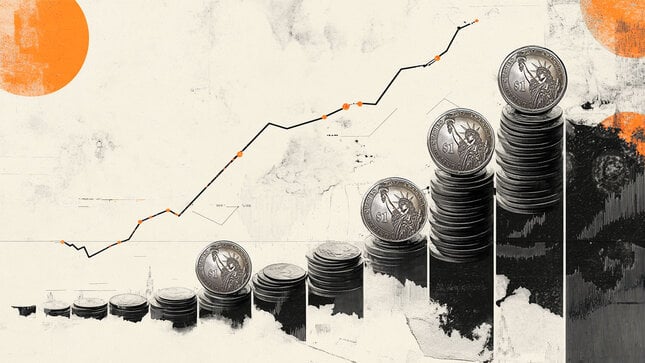As the Great Reset proceeds from globalist think tanks and technology billionaires to allied media elites, governments, schools, and Woke corporations, what will be “reset” next?
Supporters of the World Economic Forum’s all-encompassing Great Reset agenda are eyeing BIG changes for the global monetary system.
Plans that might once have been dismissed as pure speculation or conspiracy theories are now being openly pushed by people who occupy the highest levels of power.
President Joe Biden’s economic policies were grafted directly from the “build back better" language of the Great Reset’s authors.
Biden’s agenda for the economy is now being spearheaded by Treasury Secretary Janet Yellen. The former Federal Reserve chair has taken a particular interest in stamping out cryptocurrencies and expanding the reach of the International Monetary Fund (IMF) – which could ultimately be the issuer of a new global digital currency.
Bitcoin’s recent surge to $1 trillion in market value (it has since pulled back some) irked central bankers and government officials.
While they have long complained that cryptocurrencies are, supposedly, a major vehicle for fraud and other illegal transactions, officials are now focusing their ire on crypto-mining’s energy usage.
Since the Great Reset prescribes a transition to a “sustainable” economy, anything tied to resource consumption is now subject to being attacked.
Yellen derided Bitcoin as “an extremely inefficient way to conduct transactions” because “the amount of energy consumed in processing those transactions is staggering.”
A report just released on Monday by Citi (“Bitcoin: At the Tipping Point”) makes the case that Bitcoin could become the currency of choice for international trade within seven years. That assumes governments won’t act in conjunction to ban or co-opt the technology to ensure they maintain “legal tender” monopolies.
In principle, Yellen and her global central planning cohorts support the digitization of money. In fact, they are enthusiastic about the prospects for replacing circulating paper cash with digital tokens.
They just want to make sure those digits are issued and controlled by governments and central banks.
'New Blueprint for Worldwide Inflation'
Last Thursday, Yellen told the G20 the United States would back a new issuance of the IMF’s international reserve asset, known as a Special Drawing Right (SDR).
The move, which reverses the opposition of the Trump administration, will direct liquidity to poor countries struggling to recover from the coronavirus downturn on their own.
SDRs were last issued in 2009, in part to address liquidity concerns, in part to build a precedent for something bigger down the road.
In 2011, the IMF issued its first blueprint for replacing the U.S. dollar as the world’s reserve currency with a global SDR regime.
And in 2016, the IMF added the Chinese yuan to the SDR basket, elevating China’s Communist government to prominence on the world monetary stage.
Economist James G. Rickards predicts, “Over the next several years, we will see the issuance of SDRs to transnational organizations, such as the U.N. and World Bank, to be spent on climate change infrastructure and other elite pet projects outside the supervision of any democratically elected bodies. I call this the New Blueprint for Worldwide Inflation.”
Rickards views the Great Reset of the monetary system as being ultimately bullish for precious metals. The push to digitize and globalize the U.S. dollar will only accelerate the demise of its value and increase the need for investors to hold tangible safe havens.
Yellen, Powell Openly Push for Digital Dollar
If the Federal Reserve, perhaps in coordination with the IMF, attains the ability to inject stimulus directly into digital wallets, then Quantitative Easing could take a whole new meaning. Central bankers could bypass Congress and distribute their own aid as they see fit.
Treasury Secretary Yellen recently told the New York Times, “Too many Americans really don’t have access to easy payment systems and to banking accounts, and I think this is something that a digital dollar — a central bank digital currency — could help with. I think it could result in faster, safer and cheaper payments.”
A central bank digital currency might also result in the imposition of negative interest rates or the automatic deduction of taxes with no way for holders to escape… except by exiting the dollar-denominated financial system entirely.
Federal Reserve Chairman Jerome Powell told Congress last week that the Fed is indeed “looking carefully” at issuing a digital dollar, calling it “a high priority project for us."
Anyone who is concerned about the prospect of being herded into a new digital currency regime should make it a high priority to own tangible money that exists outside the financial system.
No technology or government mandate can change the fact that gold and silver have universally recognized, inflation-resistant value.
Money Metals Exchange and its staff do not act as personal investment advisors for any specific individual. Nor do we advocate the purchase or sale of any regulated security listed on any exchange for any specific individual. Readers and customers should be aware that, although our track record is excellent, investment markets have inherent risks and there can be no guarantee of future profits. Likewise, our past performance does not assure the same future. You are responsible for your investment decisions, and they should be made in consultation with your own advisors. By purchasing through Money Metals, you understand our company not responsible for any losses caused by your investment decisions, nor do we have any claim to any market gains you may enjoy. This Website is provided “as is,” and Money Metals disclaims all warranties (express or implied) and any and all responsibility or liability for the accuracy, legality, reliability, or availability of any content on the Website.
Recommended Content
Editors’ Picks

GBP/USD stays pressured toward 1.2900 ahead of UK Budget Report
GBP/USD remains under pressured toward 1.2900 in the European session after the UK's ONS reported that the annual CPI inflation softened to 2.8% in February from 3% in January. This reading came in below the market expectation of 2.9%, weighing on the Pound Sterling ahead of the UK Budget Report.

EUR/USD wavers near 1.0800, US data eyed
EUR/USD trades sideway near 1.0800 in Wednesday's European trading hours as the US Dollar struggles amid the latest tariff threats by US President Trump. Dovish ECB commentary limits the pair's upside ahead of US data and Fedspeak.

Gold bid with Copper rising to record high on tariff threat
Gold’s price is heading to $3,020 at the time of writing on Wednesday and has turned this week’s performance positive after its initial move lower on Monday. The precious metal is being bought together with other precious metals as Copper pops to a new all-time high.

Shiba Inu Price Forecast: SHIB rallies as trading volume rises 228% amid increase in bullish bets
Shiba Inu (SHIB) price extends its gains by 8% and trades at $0.000015 at the time of writing on Wednesday, rallying over 15% so far this week.

Seven Fundamentals for the Week: Tariff news, fresh surveys, the Fed's preferred inflation gauge are eyed Premium
Reports and rumors ahead of Trump’s reciprocal tariffs announcement next week will continue moving markets. Business and consumer surveys will try to gauge where the US economy is heading. Core PCE, the Fed's preferred inflation gauge, is eyed late in the week.

The Best brokers to trade EUR/USD
SPONSORED Discover the top brokers for trading EUR/USD in 2025. Our list features brokers with competitive spreads, fast execution, and powerful platforms. Whether you're a beginner or an expert, find the right partner to navigate the dynamic Forex market.